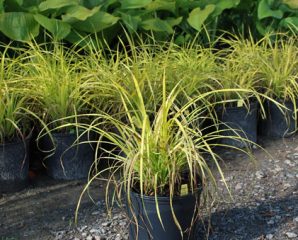Carex are grass-like plants considered by many to be ‘too little known and too little used in the garden’. Even though the flowers are not very significant, the foliage easily makes up for that. The soft arching blades range in color from green to gold to blue and even variegated. Great as a groundcover, garden accent, in window boxes and containers. Also a nice choice for modern landscapes – it looks great with hardscape!
Most Sedges do best in sun to partial shade. Many can tolerate wet feet but will also grow in drier conditions. Generally speaking, deciduous Carex should be cut back in spring and evergreen/semi-evergreen varieties should be cut back occasionally in late spring to clean up older foliage. Here are a few of our offerings:
Carex elata ‘Bowles Golden’ Graceful clumps of thin, bright gold foliage bloom in May. Needs moist soil in full sun where it will have the best color. Tolerates somewhat drier conditions in part shade. It will grow about 2’x2′. Native to Europe.
C. glauca (C. flacca) Blue Sedge is an evergreen clumping grass with a steel blue color, 9-12″. Spreads slow and steady forming a nice groundcover for full sun to light shade. Very drought tolerant. Southern European native.
C. morrowii ‘Ice Dance’ 12″ tall with white variegation ½” wide blades. Foliage is crisp and neat. Evergreen clumps spread readily. Sun to partial shade in moist soil. Native to central Japan.
C. plantaginea (Seersucker Sedge) is an eastern U.S. native that grows 1-3′ tall and wide. It blooms on slender stems with dark purple banding and an interesting tufted-like flower. Native to North America.
C. stricta (Tussock Sedge) Rich green, finer textured foliage on this Sedge that grows 3′ x 3′. Tolerates standing water. Native to the central U.S.
C. vulpinoidea (Fox Sedge) Graceful light green blades form a clump that grows 1-3′ h and gets 1-2′ wide. Has an interesting flower that blooms May-June. Likes moist soil in the woodland or along streams and ponds. Like most Carex it’s deer resistant and low maintenance. North American native.

